 I’ve come across a most remarkable field area. I think I’m probably the first Geologist to study it. The samples are an extreme case of ‘float’ – they are very detached from bedrock. Exposure is excellent. Samples are nicely polished and form neat pavements, but blocks are never large and randomly arranged.
I’ve come across a most remarkable field area. I think I’m probably the first Geologist to study it. The samples are an extreme case of ‘float’ – they are very detached from bedrock. Exposure is excellent. Samples are nicely polished and form neat pavements, but blocks are never large and randomly arranged.
Field work is a little odd. In order to get access to the samples I have to wear some very unusual field-gear – shiny shoes, suit and tie. The samples are concentrated in special areas – the names used by the local people are ‘the lobby’ and ‘the gents’. I’ve heard that samples are also to be found in ‘the ladies’ but I am not allowed in this area due to local taboo. This is a frustration, as is the fact that taking samples is not allowed. Photography is fraught with hazard also, as I am doing fieldwork ‘undercover’. The locals are unlikely to understand why I am photographing the floor. Photography in ‘the gents’, while not explicitly taboo, is highly unorthodox. My smart phone is my friend.
I’ve battled with these hazardous conditions and returned with some photos of rather nice rocks, just for you.
Here is a typical sample:
The field of view is about 50cm top to bottom. The rock is a poorly sorted sandstone. Clasts are irregular in size and volcanic in origin, some are intraclasts, samples of the sediment reworked as big pebbles. Note the minor faults.
Here’s a look at an unbedded sample with large clasts, ‘shiny’ shoe for scale (for those of you who like precision, I take size 9 shoes which is 10 in US size, 44 European).
 A more typical sample has lots of sedimentary features and shinier shoes.
A more typical sample has lots of sedimentary features and shinier shoes.
You can see there is lots of fine bedding with large variation in grain size. Note the wavy shape of the lowest bed. Once the bottom gray layer was sitting there quite happily when something came along and scooped out three big bites. Later sediment filled these in until eventually the layers on top are flat again. What did this? A clue is in the big white clast sitting bottom right. In order to move something that big, you need fast moving water. I’m thinking turbidity currents and my guess is that the ‘scoops’ are cross sections through flute marks or other types of gouges that these big flows of sediment-rich water produce.
So I’m visualising somewhere near volcanoes, steep underwater slopes down which big piles of sediment-rich water periodically sweep. What do you often get associated with volcanoes? Earthquakes. Shaking up piles of sediment can do some very interesting things.
First the faulting. You saw some in the first picture and you probably visualised this as something that happened to the sediments long after they were lithified. Maybe. Have a look at this.
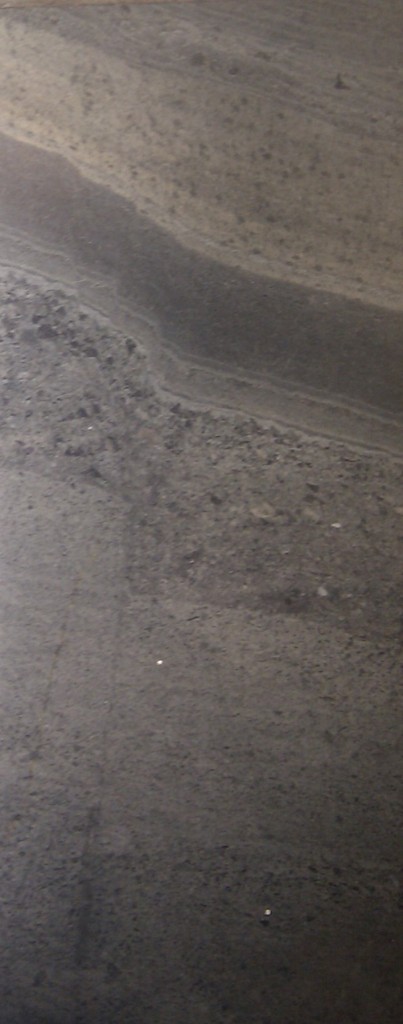
I know its not the world’s best photo, any advice on discretely taking photos of shiny surfaces in dark corners gratefully received. The short dimension is 8 centimetres. Here’s an annotated version to make things clearer.
 Green lines are sedimentary boundaries. The bottom one is clearly cut by a single fault. The second one is cut by a few minor faults and seems a little folded next to the faults. The top one is unfaulted. Did the faults simply peter out and not reach the top layer? I’m not so sure, look at the layer immediately beneath the top boundary. It is thicker above the downthrown side (the right). It looks to me like this faulting happened while the sediments were forming. The top layer isn’t faulted as it wasn’t there when the faulting happened. I’ve not traced the faults thorough the thick layer, as there the disruption seems a bit more diffuse, which I guess is also consistent with fracturing of unlithified sediments.
Green lines are sedimentary boundaries. The bottom one is clearly cut by a single fault. The second one is cut by a few minor faults and seems a little folded next to the faults. The top one is unfaulted. Did the faults simply peter out and not reach the top layer? I’m not so sure, look at the layer immediately beneath the top boundary. It is thicker above the downthrown side (the right). It looks to me like this faulting happened while the sediments were forming. The top layer isn’t faulted as it wasn’t there when the faulting happened. I’ve not traced the faults thorough the thick layer, as there the disruption seems a bit more diffuse, which I guess is also consistent with fracturing of unlithified sediments.
This is all on a tiny scale, but a similar process happens on a km scale, where faulting in sedimentary basins can be the main control over sediment thickness.
What happens if you pile coarse sand on top of web mud and shake it? Here’s what: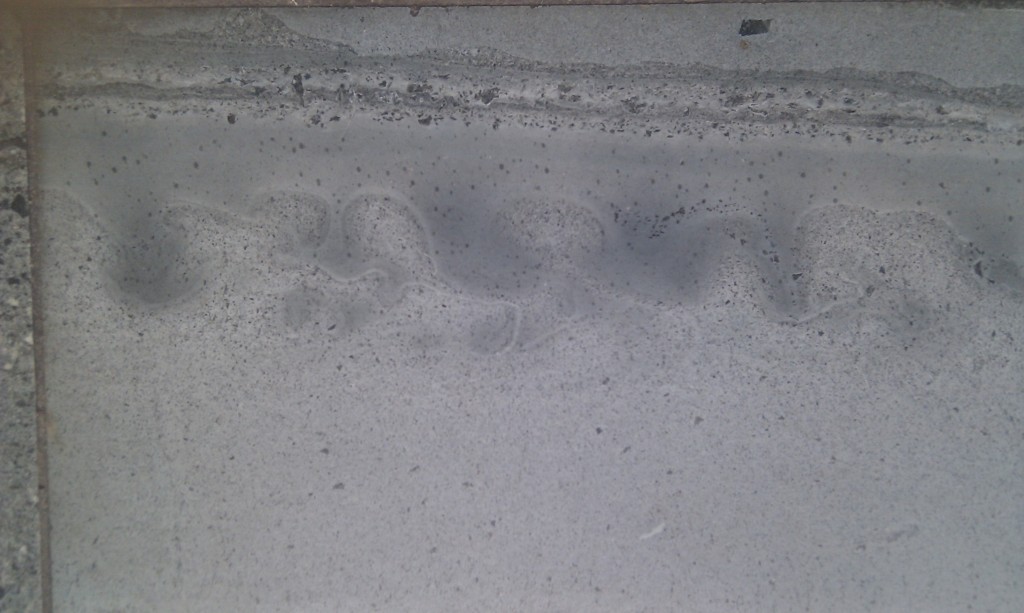
Firstly, did you assume that this photo is the right way up? Looking at the irregular top boundary I think it is ‘upside down’. I thought of rotating the photo to match the orientation when the sediments were laid down, but that is only my interpretation as I’ve no way of knowing for certain. If you work in structurally exciting areas, the ability to tell a sedimentary rock is upside-down is a useful skill.
Look a the layers about a third of the way down. The coarse sand was sitting on the finer-grained mud. When the sediment was shaken by an earthquake, the heavier sand started to sink as lobes into the mud. Displaced mud moved to fill the space, the earthquake stopped, eventually the rock lithified and froze this rather nice blobby-wobbly structure in place. I believe convolute bedding is a more generally accepted term.
Here’s a more dramatic example.
The rocks are rather green. They may have been metamorphosed slightly, just enough to grown green minerals such as epidote or chlorite, but not enough to recrystallise so much that sedimentary features are lost. A few samples look as if they might have some spaced cleavage in them.
My attitude to sedimentary rocks is usually summed up by the word ‘protolith’, but these are so nice I’m almost converted. I still don’t where these rocks are from originally as the records of the people who placed them here are lost. Any ideas? Also, any other features I should be looking out for?
I’ll end on a mystery. It looks like boudinage, but the folded layers are cut by higher ones which seems to rule out deformation. What is it?


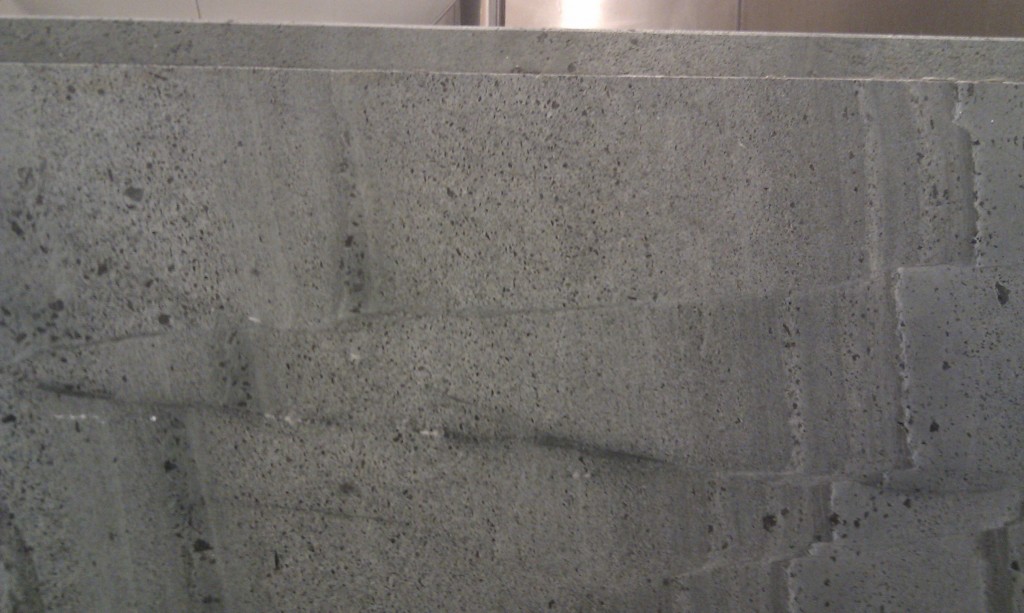
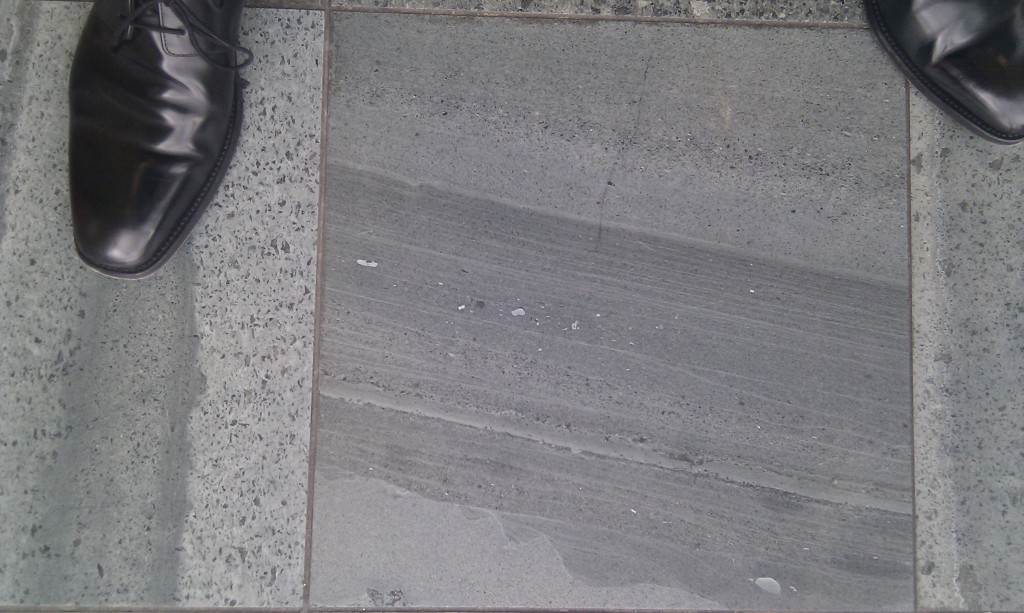
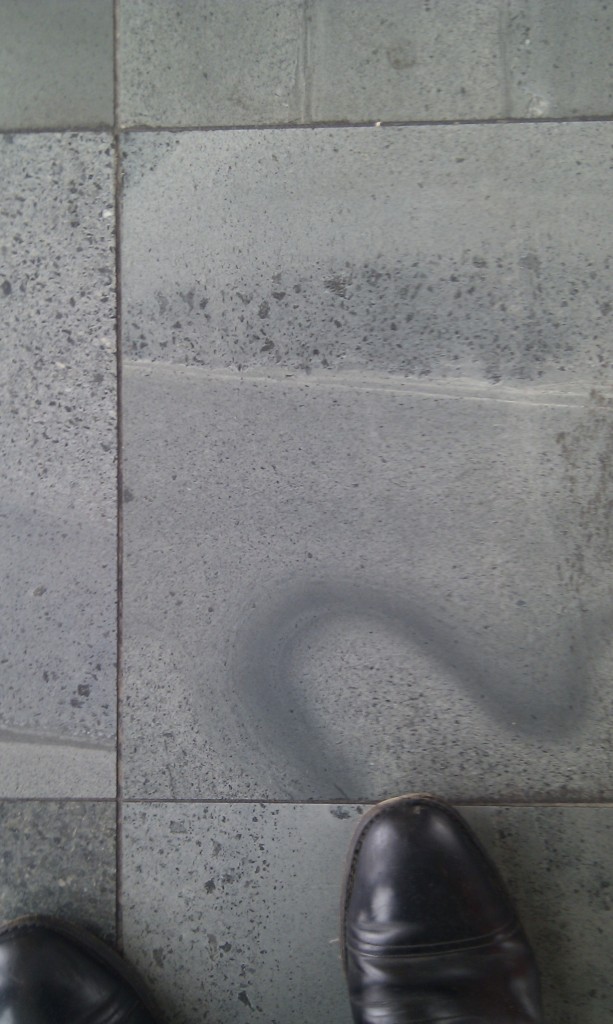
Very cool rocks! The things you can see when you’re wearing shiny shoes!
I would say the beds in the last picture are upside down, and the bedding is disrupted by penecontemporaneous dewatering structures. How appropriate if this one was in “the gents”!
Beautiful! I agree, these look like turbidites — graded beds, syn-sed faulting, soft-sed deformation (loading and dewatering features), all that great stuff.
Very cool.
Heh – this reminds me of when I was in grad school at Tennessee my adviser took us to see some of the best outcrops of the Holston Limestone around (and to examine some really great examples of stylolites): in a campus bathroom (used for the stall separation walls in the older buildings).
Can I just say this is one of my favorite things ever? Geology in the men’s! LOL. If you ever need anyone to do some field work in the ladies’, you just let me know when and where. Love these rocks!
Pingback: Stuff we linked to on Twitter last week | Highly Allochthonous
Shiny shoe geology. I’ve been known to return from field trips much later than my partner, contrary to all stereotypes. Sometimes I don’t even make it out of the common area….
Pingback: Labradorite: butterflies and poetry | Metageologist
Pingback: Granite and green shoes (AW #42) | Metageologist
haha, classic article, made me have a chuckle, still beside the funny side i saw it was never the less very interesting, geology in the loo 🙂 might take on as a trend 🙂
I don’t know for sure, but based on a sample in the Oxford museum of natural history that looks identical, the stones may have come from Kirkstone Pass quarry in Cumbria.
This would make these volcanic sediments. This material may have been freshly erupted ash as it settled to the bottom of the sea.